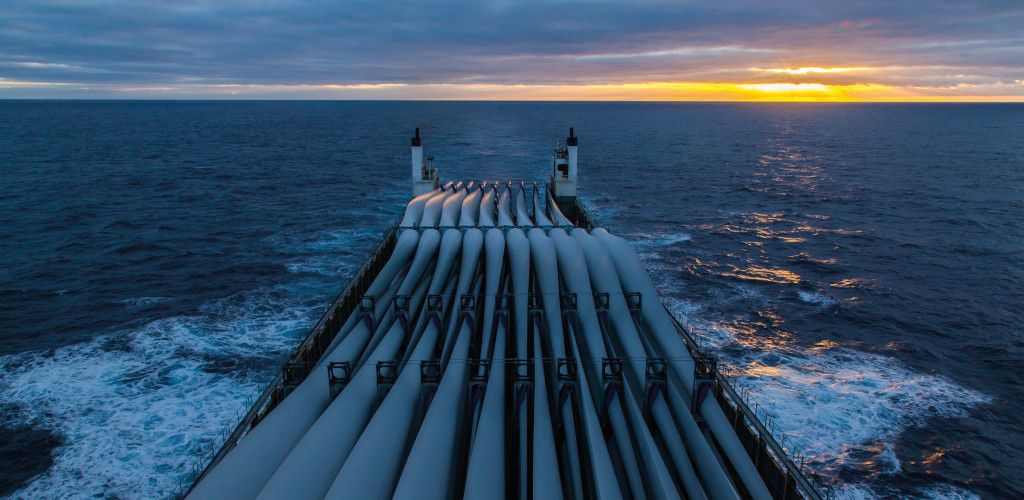Feb 10 | 2024
Train, Maintain, Standardize and Heed Advice, Breakbulk Sector Told

By Iain Macintyre
Breakbulk and general cargo vessel losses are the highest of all categories of ships. We find out from industry experts how you can reduce your risk.
From Issue 1, 2024 of Breakbulk Magazine.
A commitment to crew training, maintenance and technology, standardizing where possible and following insurers’ best practice safety advice are among key recommendations to reducing breakbulk shipping sector risk in an environment of ever-rising insurance premiums.
The industry by its very nature of being predicated on non-standardized cargoes comes with higher, inherent risks than other modes. This is evidenced by Captain Rahul Khanna, global head of Allianz Commercial Marine Risk Consulting, who observed there were 311 breakbulk/general cargo vessel losses in the past decade – “the highest in all categories [of ships].”
“The second category is fishing vessels with 117 ships lost in the same period,” he said. “In my experience, standards of safety on breakbulk ships do not match up to other specialized segments like tankers. Having said that, within this segment there are ships like the heavy-lift vessels which perform a lot better and appear to have better safety standards.”
 Khanna believed investment in crew training is the most effective measure to mitigate risks in the sector. “Well-trained crew can be the best defense against incidents and accidents. Machinery damage/breakdown is the top cause out of the 3,032 incidents recorded in 2022, hence having a robust, planned maintenance program is key to avoiding these incidents.”
Khanna believed investment in crew training is the most effective measure to mitigate risks in the sector. “Well-trained crew can be the best defense against incidents and accidents. Machinery damage/breakdown is the top cause out of the 3,032 incidents recorded in 2022, hence having a robust, planned maintenance program is key to avoiding these incidents.”Too often, he said, maintenance budgets are squeezed during a downturn in freight rates, while a large number of cargo damage claims from breakbulk ships are the result of not following best practice in cargo stowage and securing.
“Today, technology can greatly assist in cost-effective implementation of the above recommendations and ship operators should consider investing in proven tech to mitigate risks from the bridge to the engine room,” he said.
To help guide such endeavors, Allianz regularly publishes risk bulletins and white papers on emerging and trending risks to share knowledge and experience with shipowners and operators.
“Some of these are applicable to all segments of shipping but some are targeted at breakbulk shipping. P&I clubs are also very active in providing advisory information to shipping. It is rather difficult to measure the uptake of such advice, but during client visits we often pass on such material and discuss the benefits of following through.”
Odd Shapes and Sizes
The absence of standardization in breakbulk transportation has “always posed security challenges,” according to AXA Australia Head of Marine, Tom Hughes.
“Breakbulk cargoes typically include items that cannot fit into standard-sized containers due to their size, weight, or nature, such as heavy machinery, large construction equipment and oversized items,” he said. “Often exposed to the elements, there is the heightened risk of these goods being lost, stolen or damaged during transit due to contact with other packages. The lack of uniform storage conditions also makes breakbulk transportation less secure than containerized shipping methods.”
 Additionally, human error adds to the challenges of breakbulk transportation. “Although it may not require a crane for unloading, it often involves a great deal of manual labor. Consequently, the unloading process at a port can incur higher costs, adding another aspect for our insureds to consider when tallying their final shipping expenses.”
Additionally, human error adds to the challenges of breakbulk transportation. “Although it may not require a crane for unloading, it often involves a great deal of manual labor. Consequently, the unloading process at a port can incur higher costs, adding another aspect for our insureds to consider when tallying their final shipping expenses.”Hughes noted that with the loading and unloading of breakbulk typically falling under the responsibility of ports and largely being a mechanized process, the main challenge is managing the heightened resource requirement at terminals.
“This method tends to need more dock space, given that multiple vessels may transport diverse loads of breakbulk cargo,” he said. “Some argue that the absence of standardization in the breakbulk sector has impeded the widespread adoption of sustainable practices. Nevertheless, there is a noticeable shift towards collaborative initiatives aimed at establishing universal standards and best practices as all stakeholders strive for a greener future.”
In response to an increasing demand for sustainability, breakbulk shipping is evolving, with shipping companies actively exploring greener technologies such as alternative fuels and more energy-efficient vessels. Efforts are also underway to minimize carbon emissions, cut down on waste and promote eco-friendly practices within the industry, he added.
Non-critical Concern
While predicting the breakbulk shipping sector is poised for substantial growth to support various projects globally, given the anticipated expansion in the renewable energy sector, Hughes issued a note of caution.
“The transportation of critical items such as generators, wind turbines, solar panels and other renewable energy equipment present unique opportunities for breakbulk shipping companies. However, there is a growing concern about the complacency in shipping what could be termed as non-critical project cargoes. Unlike critical items, these may not expose the project to significant financial losses if their timely delivery is delayed, as replacement items or parts are typically more readily available.”
In recent years the sector has seen widespread parts shortages, port congestion challenges and inadequate supply chain management. “Additionally, these non-critical items can still be of high value, oversized or sensitive in nature, demanding the right level of care and attention to ensure they reach their destination in good condition,” he said.
AXA Marine Senior Risk Consultant Jarek Klimczak said that, despite the conservative nature of the shipping industry and “old-fashioned maritime laws,” external factors and technology are driving positive changes in breakbulk transportation.
These include:
• Supply chain traceability gaining importance and addressing concerns about product safety, sustainability and ethical sourcing. “Regulatory obligations require companies to conduct due diligence on their supply chains, identifying and addressing human rights and environmental risks,” he said.
• Increasing technology integration in breakbulk operations, including the adoption of real-time visibility sensors. “This enables better route planning based on forecasted weather and port congestions, and understating asset aggregation in areas prone to natural disasters.”
• Increasing data analytics. “Although still slowly employed in breakbulk, using historical data to identify risks and optimize operations improves efficiency and safety.”
• Operators in breakbulk shipping focusing on improving packaging and handling techniques for heavy or oversized items, “minimizing the risk of damage during loading, unloading and transportation.”
Plethora of Advice
Klimczak believed the marine insurance sector is “uniquely positioned” to offer comprehensive advice. “With access to historical claims data, insurers can conduct thorough risk assessments. They can identify patterns and trends related to specific types of incidents, helping them understand and quantify risks associated with different aspects of the marine industry,” he said.
By analyzing past claims data, insurers can develop effective loss-prevention strategies and can provide clients with recommendations on how to minimize the likelihood of events occurring, thereby reducing the overall frequency and severity of claims.
Skuld (Far East) master mariner/technical manager Captain Jia Hong Liu, describing breakbulk shipping as “by far the most important form of maritime transport in the world,” said that the industry can reduce risks by maintaining high standards of ship and terminal management. To this end, he praised P&I clubs for the regular advice they provide to help guide safety practices in the industry.
As to whether some breakbulk carriers might be underinsuring to reduce costs in the current market environment, Liu said possibly, noting that it usually happens with hull insurance for ships.
AXA’s Hughes added that, exacerbated by rising inflation, underinsurance is an issue that insurers will be “tracking closely over the coming months and years.”
“The unique cargo handling requirements associated with breakbulk shipping have certainly raised costs, however, it is difficult to determine the extent to which this may have led to underinsurance in the marine industry,” he said.
“Ultimately, we don’t want to see a trend in rising claims severity where high-valued cargoes have been significantly underinsured. Similarly, there should be consideration for regularly reviewing policy limits, particularly multi-year project insurance policies, which may need to be adjusted to reflect rising insured values.”
